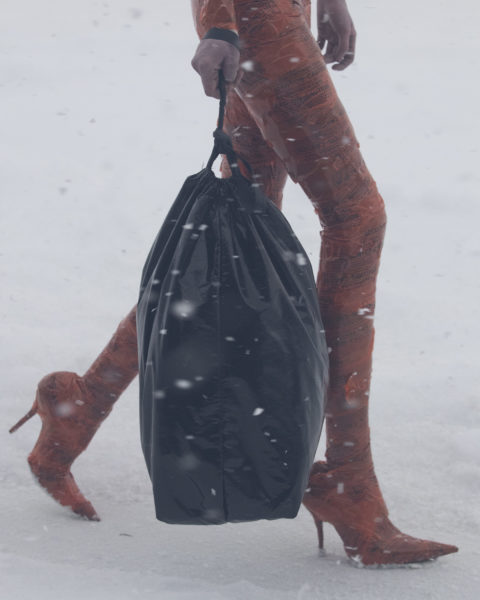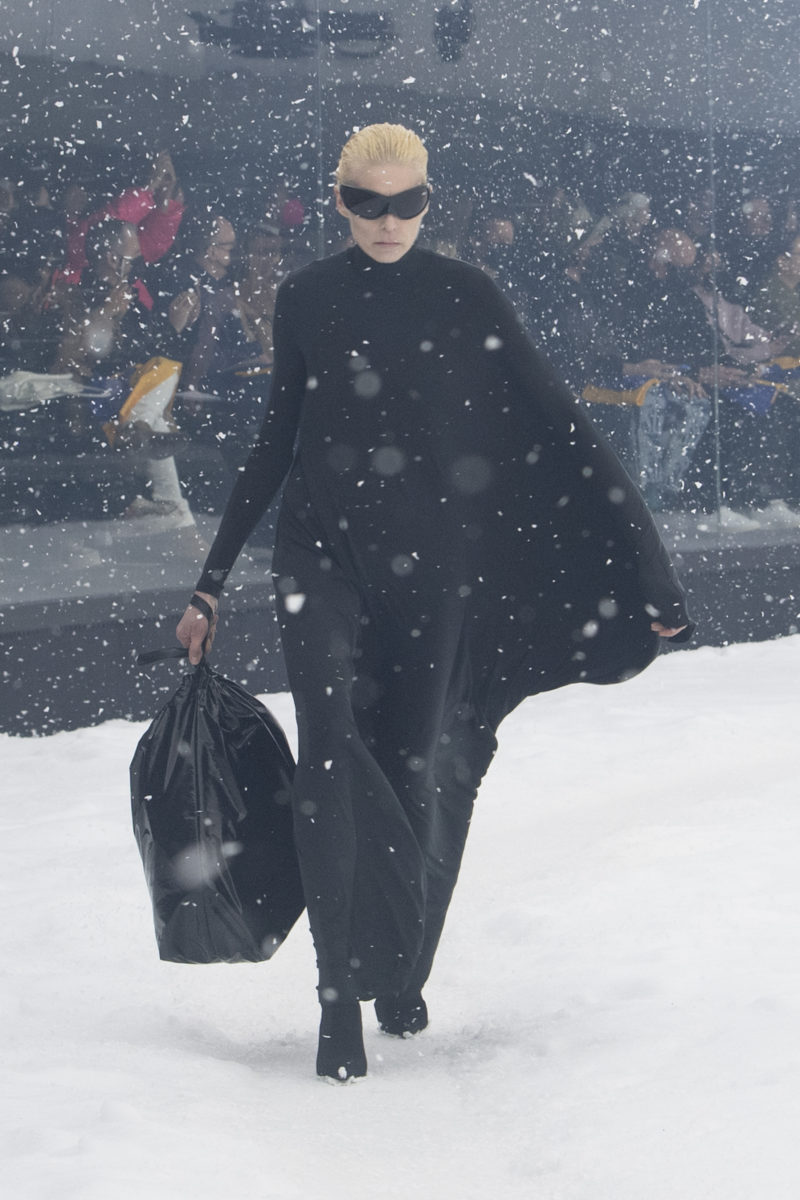As Russia’s attack on Ukraine intensifies, fashion month presentations hold a deeper symbolism.
As models trudged through a harsh, man-made snowstorm at Balenciaga’s Paris Fashion Week presentation on March 6, the show’s message became glaringly obvious: if art imitates life, the world is in a dire state.
Since Russia’s invasion of Ukraine on February 24, midway through fashion month, designers have grappled with their role. In an industry that is often viewed as frivolous, it’s difficult to celebrate the art and creativity of clothing with war raging on, not only in Ukraine but in other parts of the world like Palestine, Yemen, South Sudan and Syria.
Tensions behind the Russia-Ukraine conflict had been building for years, with Russian nationalists led by president Vladimir Putin insisting that Ukraine was manipulated into seeking independence after the dissolution of the Soviet Union and that the Eastern European country shouldn’t exist as a sovereign nation. As of March 6, nearly 400 Ukrainians have died and hundreds more have been injured from the attacks.
As Milan and Paris Fashion Weeks overlapped with the invasion, we’re reminded of how global crises can refigure our relationship to clothing. Hence the Balenciaga show. Designer Demna had originally planned the simulated blizzard as a statement on climate change and the imminent disappearance of snow due to global warming. But against the backdrop of war in Ukraine, the presentation’s setting took on new meaning.

For one, Demna himself was a refugee. In the early 1990s, at just 12 years old, the designer and his family were forced to flee their home country of Georgia during the Abkhaz-Georgian conflict. At the Balenciaga show, Demna left a note on each seat explaining how the experience made him “a forever refugee.”
“That’s something that stays with you,” the statement continued. “The fear, the desperation, the realization that no one wants you.” The note included a classic Ukrainian poem, and guests were given blue and yellow T-shirts to symbolize the country’s flag.
The show itself was sombre and dystopian, showcasing dark hues, capes and duct tape bodysuits, including a yellow Balenciaga-branded caution tape ensemble (which Kim Kardashian wore to the show). Models looked noticeably uncomfortable as they struggled through the windy snowstorm. Some lugged stuffed trash bags, and others appeared to shiver in shorts with only a blanket wrapped around them for shelter.
Protection — or lack thereof — has been an ongoing theme throughout Paris Fashion Week. Heading into the start of events on February 28, organizers released a statement encouraging viewers to experience the shows “with solemnity, and in reflection of these dark hours.”
Balmain’s presentation on March 2 was a commentary on how fashion reflects current events, featuring metallic body armour, protective vests, padded sleeves and knee coverings. Ahead of the show, creative director Olivier Rousteing noted that the designs weren’t made as a response to the invasion in Ukraine, but that the show’s meaning can be applied to the conflict.
“United in solidarity, we can rely on the power of hope and truth to push back against hate, lies and aggression,” Rousteing said in a statement describing the show’s message, which was originally pegged to social media conflicts. Fittingly, the presentation opened with a choreographed performance, where dancers dressed as soldiers appeared to fight one another.
Dior designer Maria Grazia Chiuri told AFP her focus on combining “beauty and protection,” while originally a response to COVID-19, was fitting for a time of war. With airbag padding, thick motorcycle gloves, bulletproof vests, inflated shoulder pads, leather jumpsuits and reflective patterns, the catwalk was a clear reference to the use of clothing as a shield.
Some designers have shied away from fashion’s fanciful elements in an effort to acknowledge the tragedy in Ukraine. Giorgio Armani, for instance, opted to present his collection at Milan Fashion Week on February 28 in silence as a sign of respect. But other labels, like Valentino, have leaned into over-the-top presentations as a form of defiance. The Italian luxury house opened its show on March 6 with a voice-over from designer Pierpaolo Piccioli addressing the people of Ukraine: “We see you, we feel you, we love you.”
The show that followed was centered around the most unapologetic of all colours: hot pink. Permeating the walls, the floors and most of the garments, the colour symbolizes the power of the individual and was an uplifting reminder of style as a form of noncompliance.
Fashion has been ushering in an era of protective dressing for some time to reflect the turbulent epoch set off by the 2020s. Case in point: on March 3, French designer Ludovic de Saint Sernin tapped into the growing trend of armour as everyday wear, showcasing chainmail textiles that signify strength and security.
Apart from making statements through art, the clothing industry is notoriously affluent and influential. Many fashion powerhouses have thus acknowledged the attacks in Ukraine by making donations, and some have temporarily closed their stores in Russia, including H&M, Chanel, Hermès and Gucci.
Individual figures in the industry are making their own statements, too. In an Instagram post on March 6, model Gigi Hadid pledged to give her entire fashion month earnings to the cause, along with her friend and fellow model Mica Argañaraz.
“I am pledging to donate my earnings from the Fall 2022 shows to aid those suffering from the war in Ukraine, as well as continuing to support those experiencing the same in Palestine,” Hadid wrote. “Our eyes and hearts must be open to all human injustice.”
While it seems odd to celebrate new clothing lines with such terrible catastrophes at play, the fashion industry has always reflected reality. The pandemic, for instance, introduced an era of comfortable dressing and digital fashion that has spread throughout the globe. And historical conflicts like WWI altered the trajectory of womenswear by replacing corsets with bras and introducing pockets as more women entered the workforce.
Ultimately, fashion’s current form reflects our need for protection and security, whether it’s from climate change, the looming pandemic or wartime violence.
As Paris Fashion Week and its debuted designs come to an end, Ukraine continues to be under attack by Russia. Charity Intelligence Canada, an organization that assesses the transparency and accountability of charities, has compiled a list of credible organizations offering humanitarian aid in Ukraine. For those looking to donate, that list can be found here.
